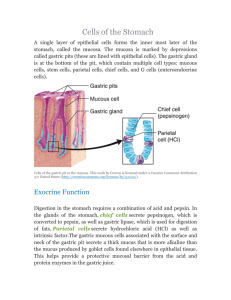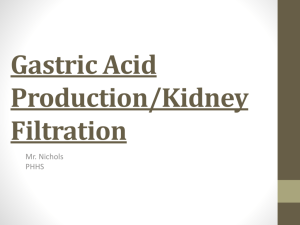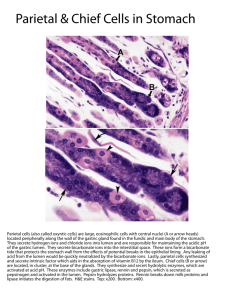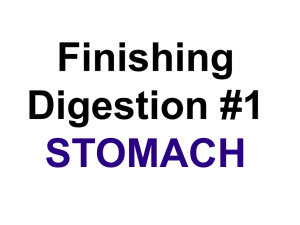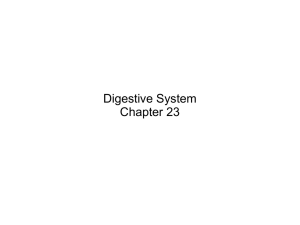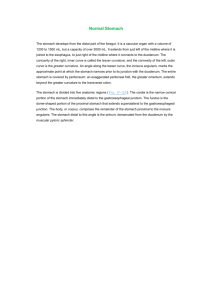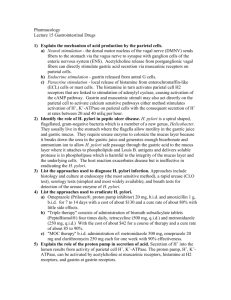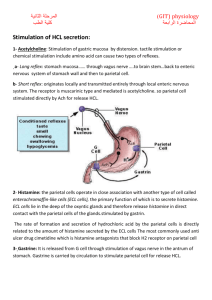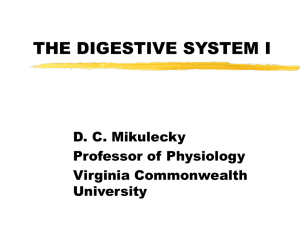010710.JHemberg.Stomach
advertisement
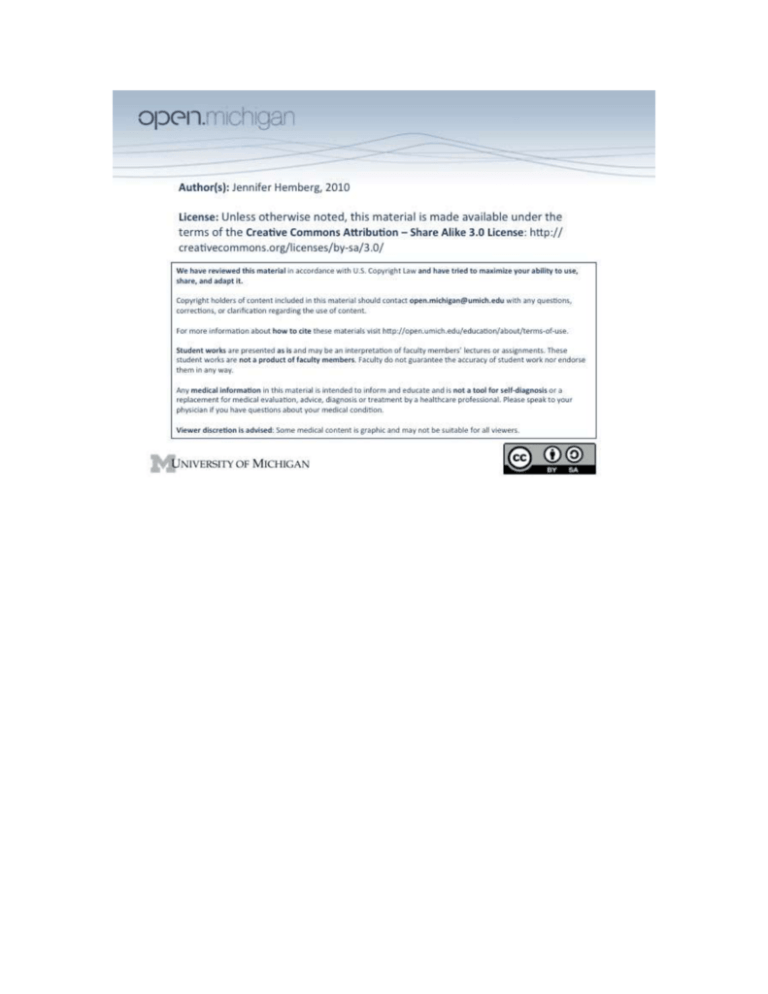
STOMACH Functions o Storage of ingested meal o Inhibition of bacterial growth o Mixing contents of stomach o Physical breakdown of food into small particles, some components solubilized o Regulates reate of emptying into small intestine o Provides intrinsic factor for vitamin B12 absorption Body of stomach o Structure of gastric gland Mucus epithelial cells and overlying mucus contribute to gastric mucosal barrier Parietal cells secrete hydrochloric acid and intrinsic fact In fundus and body Chief cells produce and secrete pepsinogen Fundus, body, and antrum ECL cells synthesis and release histamine Do not contact gland lumen Mucus neck cells include stem cells which divide, differentiate and move up and down the gland in normal cellular turnover Endocrine cells Somatostatin and ghrelin from fundus Gastrin and somatostatin from antrum Secretion of HCl by Parietal Cells o CO2 diffuses into parietal cells from plasma or is produced by cellular metabolism o Hydrated to H2CO3 via carbonic anhydrase and dissociates to H and HCO3o At apical membrane H+ is transported out of the cell in exchange for K+ by H+/K+ ATPase ATPase is a target for proton pump inhibitors Activated in the acid environment of the gastric gland At rest, most are within the cell in inactive form and with stimulation of parietal cells they fuse to luminal membrane Activation includes Gastrin, ACh, and histamine Activation shows potentiation of response o Cl- exits passives through a Cl- channel Integrated control of Gastric Acid secretion o Vagus acts directly on parietal cells and indirectly by effects on gastrin and histamine release o Histamine released from ECL cells reaches parietal cells by local diffusion o Gastrin released from antral G cells reaches parietal cells by systemic circulation o Inhibitory regulators include somatostatin released from D cells in the antrum and body of the stomach, prostagladin from surface cells and intestinal hormones collectively termed “enterogastrone” Pepsin o Proteolytic enzyme secreted by chief cells as an inactive precursor, pepsinogen o Release stimulated by vagal nerve and by presence of acid in stomach o Activated by peptide cleavage at acid pH o Initiates digestion of protein Endopeptidase acting on internal peptide bonds Products are large peptides called peptones (potent stimulators of gastrin and CCK release) Intrinsic Factor o Glycoprotein which binds Vitamin B12 o Produced by Parietal cells o After binding B12 its binds receptors on ileal absorptive cells and is internalized by endocytosis o Absent in pernicious anemia Gastric Mucosal Barrier o Protection against acid and pepsin o Includes: Prominent mucous layer Bicarbonate secreted by surface cells which sets up a pH gradient Tight junctions between epithelial cells Surfactant like molecules secreted by mucosal cells Gastric mucosal blood flow which rapidly removes any penetrating acid Gastric Motility o Proximal: Receptive relaxation as stomach fills (fundus) o Distal: propulsive mixing and grinding (antrum) Only particles smaller than 1 mm can exit through the pylorus Peristalsis initiated by pacemaker cells Muscular contraction is brought about by action potentials occurring when the smooth muscle cells depolarize below threshold Increased by vagal or gastrin stimulation Decreased by vagotomy or sympathetic stimulation o Pylorus regulates outflow Regulated to prevent overload in intestine and allow optimal digestion Increases in fatty acids, acidity, osmolarity, volume, and amino acids in the intestine leads to the release of CCK and secretrin which inhibits stomach emptying Disorders Delayed emptying (helped via use of prokinetic agents) o Outlet obstruction (tumor, scarring) o Diabetic neuropathy or vagotomy Accelerated emptying o Dumping Syndrome
